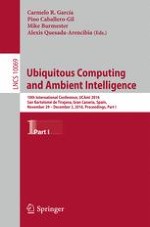This LNCS double volume LNCS 10069-10070 constitutes the refereed proceedings of the 10th International Conference on Ubiquitous Computing and Ambient Intelligence, UCAmI 2016, which includes the International Work Conference on Ambient Assisted Living (IWAAL), and the International Conference on Am-bient Intelligence for Health (AmIHEALTH), held in Las Palmas de Gran Canaria, Spain, in November/December 2016.
The 69 full papers presented together with 40 short papers and 5 doctoral consortium papers were carefully reviewed and selected from 145 submissions.
UCAmI 2016 is focused on research topics related to ambient assisted living, internet of things, smart cities, ambient intelligence for health, human-computer interaction, ad-hoc and sensor networks, and security.
